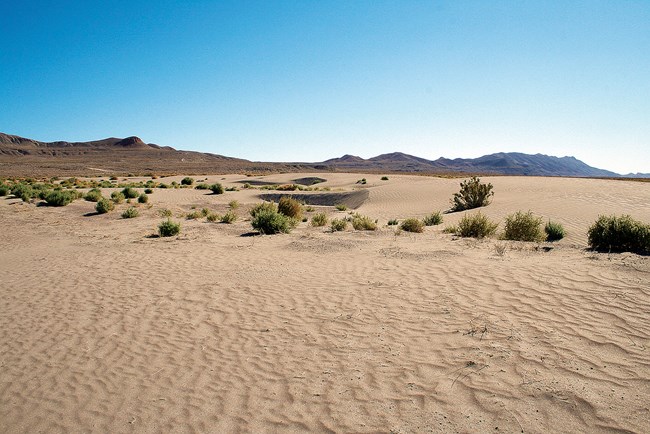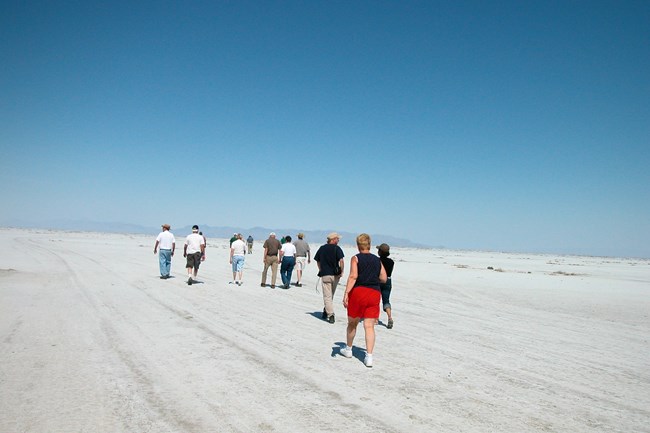Last updated: July 7, 2020
Article
Sagebrush and Salt Flats along the Overland Trails

Photo/NPS
The Great Basin is a vast, high-elevation desert that takes in almost 200,000 square miles of southeastern Idaho, western Utah, nearly all of Nevada, and slices of California and Oregon. Like a shallow bowl, the Basin catches and holds water, allowing none to escape to the Pacific. Many thousands of years ago that bowl was full of lakes, some of immense size, but today its inward-flowing streams bleed into a few isolated remnants of those ancient lakes — or choke and die at river-graveyards called sinks. In places, groundwater bubbles up into springs and expansive marshes or collects in broad, shallow playa pools that evaporate and leave a bright crust of crystallized salts.

Photo/NPS
A bone-dry playa or salt flat makes a superb road, smooth, flat, and firm; but when the underlying clay is wet, a horse or ox can break through the white crust and mire to its knees, and a wagon might sink to its axles in the muck. Wet or dry, salt playas glare like snow in the midday sun, burning unprotected eyes and skin. Midsummer daytime temperatures on the Bonneville Salt Flats west of Salt Lake City can exceed 100 ° F, and heat waves there distort the light to create surreal illusions. Out in the salt desert, travelers on the Hastings Cutoff to California might see non-existent lakes, mountains floating on air, distant rocks resembling lost cattle, and approaching pack trains magnified into fantastic, writhing serpents.

Photo/NPS
But the Great Basin is not just a big, flat salt pan: it is a bowlful of mountains. Hundreds of mountain ranges rise in roughly parallel north-south rows, separated by broad valleys. From the air, these ranges look like enormous swells cresting in a sagebrush sea. From the height of a horse, they look like serious obstacles. Anyone crossing the Basin by ox and wagon had to find a way around the mountains. Only one natural pathway cuts through this washboard barrier: the Humboldt River Valley of Nevada.
Salt desert and sagebrush steppe. Sun-tempered mountains the color of steel. Heat and eye-scalding dust, turbid streams and briny waterholes… miles and miles with no water at all. The Great Basin is stark, yet it offers a living to those who know where and when to look for food, and who keep an open mind about what makes a good meal. On the Great Basin menu are grass seeds, pine nuts, berries, cattail roots and pollen; fish and waterfowl, jackrabbits, antelope, deer, ground squirrels and lizards (few buffalo here); and ant eggs, caterpillars, crunchy grasshoppers, leggy Mormon crickets, and well-seasoned brine fly larvae that wash up in windrows along some Great Basin lake shores. Pioneers scorned many of these wild foods, although there would be times on the road ahead when they might gratefully eat much worse. But the native peoples of the desert could ill afford to be so choosy.

Photo/NPS
The riverless region southwest of the Great Salt Lake, between the Oquirrh Range of Utah and the Schell Creek Range of eastern Nevada, is some of the harshest, most food-scarce country in the Great Basin. It also is the ancestral homeland of the Goshute Shoshone Indians. When they had the desert to themselves, the Goshutes — “dry earth people” — spent most of the year scattered across the landscape in small family groups. They ranged the country on foot, keeping no horses that would eat up the seed-grasses the people needed for their own survival. The Goshutes were too few and too dispersed to form a tribe, but families gathered from time to time to cooperate in hunts and harvests. They ate whatever the earth provided, sheltered in simple brush huts and cliff-side alcoves, and carried few possessions. Isolated, desert-savvy, and resourceful, the Goshutes lived like shadows on the land, in trembling balance with nature. They had enough to survive but nothing to spare.
Although the Great Salt Lake Desert may have looked vacant, it was fully occupied, altogether and efficiently used. The arrival in the 1840s of new people and their livestock, competing for the same precious resources, would topple the delicate balance the Goshutes had maintained for many centuries.
This article is from the Auto Tour Route Interpretive Guide series.
These are state by state interpretive guides that provide an overview of local trail history and driving directions to suggested sites and points of interest that have interpretive media and/or educational services.
Auto Tour Route Interpretive Guides can also be found at many travel and tourism centers along the historic trail route.
Learn more
-
 Utah Auto Tour Route Guide
Utah Auto Tour Route GuideThe guide for the national historic trails' auto tour routes across Utah.
-
 California National Historic Trail
California National Historic TrailThe California Trail is over 5,000 miles long and covers portions of 10 states. Explore more!
Tags
- california national historic trail
- mormon pioneer national historic trail
- pony express national historic trail
- california trail
- mormon pioneer national historic trail
- mormon pioneer trail
- stories
- atr guides
- great basin
- historic trails
- national trails
- pony express national historic trail
- pony express trail
- utah
